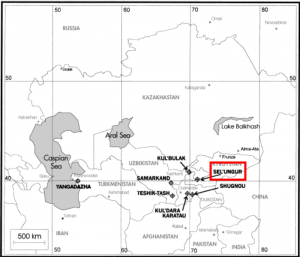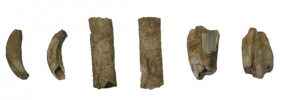Sel-Ungur
May 8, 2017
Also Known as: Sel’Ungur, Сельунгур, Сель-Унгур, Селюнгур
Coordinates: 39.95°N, 71.32°E
Originally discovered in 1955 by A.P. Okladnikov, the Sel-Ungur cave-site was officially excavated in 1980 by Islamov’s team from the Soviet Institute of Archaeology (1988). Sel-Ungur is a Lower Paleolithic site located in the Alai mountain region of Kyrgyzstan and is one of the most significant finds of Paleolithic Central Asia. Most notably, it houses human remains whose origins have been recently disputed in anthropological literature. These remains may be critical in tracing the early hominids’ pattern of migration across inner Asia. Earlier finds, such as Teshik-Tash and Obi-Rakhmat, have clearly established a Neanderthal presence in the region and even suggested that these Central Asian Neanderthals were in contact with other species of humans during that time. Further research into the Sel-Ungur site may provide us with critical insight of what types of humans were living in Central Asia and when.

Map of Lower Paleolithic sites found in Central Asia. Taken from Davis & Ranov (1999).
Cave Site
The Sel-Ungur cave is located in the Ferghana basin of the Alai mountain system at an elevation of about 1,900 meters. The entrance to the cave itself is about 50 meters above the lower portion of the Katrantau Ridge. The site is 120 m long, and its width and height at the mouth are 34m and 25m respectively. Archaeologists have identified 5 main cultural layers (0.2-0.4m thick) separated by thin strata (0.3-1.0 m thick) and lying at a depth of 2.5 to 6.5 m (Markova, 1992). A uranium-thorium date of 126,000 B.P. ± 5,000 years was obtained on a travertine sample taken from the stratum overlying the upper cultural layer (Davis & Ranov, 1999).
In an extensive paleoecological analysis of the site, Velichko et al. (1991) were able to establish that the sediment strata enclosing the cultural layers were generally homogeneous, showing no significant changes of ecological conditions during the period of the archeological layers’ formation. Put more simply, pollen and sediment sample analysis suggest that in contrast to the drastic environmental changes characteristic of Central Asia during the Lower Paleolithic, Sel-Ungur’s climate has remained relatively stable over time. As previously suggested by Glantz (2010), it is probable that the cave’s location at the base of a mountain may have shielded the site from any severe climatic fluctuations. In this way, Sel-Ungur’s relatively stable climate may have attracted long-term human settlement.

Satellite image of Sel-Ungur cave opening taken through Google Earth
Tool Industry
The Sel-Ungur site contains the oldest and most expansive tool industry found in the Ferghana region of Kyrgyzstan. 1,500 stone tools were found on site, with most items made of jasper and slate pebbles, and a few others from volcanic rock (Islamov, Zubov, & Kharitonov, 1988). The most common type of tool found were short massive flakes with wide smooth platforms. Other prevalent artifact types included choppers, side scrapers, notches, retouched flakes, and fragments. Vishnyatsky (1999) was also able to identify at least one cleaver from the items found at the site. Importantly, however, almost no blades nor prepared cores were found at Sel-Ungur. Instead, the collection is mostly derived from pebbles that have been worked by discoidal and opposed platform-core techniques.
According to Glantz (2010), the Lower Paleolithic of Central Asia is comprised of four technological industries, each of which is identified by key tool types such as Acheulian-like bifaces, pebbles, cores and flakes, and “small” artifacts. The original excavators of Sel-Ungur considered the tool industry to be Acheulean because they believed that they had found a bi-facial hand axe within the artifacts. However, Vishnyatsky (1999) considers this particular hand axe to be morphologically vague and argued that the artifact be considered a stone core instead. Consequently, in the absence of true hand axes, as well as the tools’ morphological similarities to other pebble assemblies in the region, there is reasonable argument to attribute Sel-Ungur to the group of the Lower Paleolithic pebble industries of Central Asia. This culture is not often associated with Neanderthal tool industries, and suggests that another species of human may have been inhabiting the site.

Bifacially retouched artifact from Sel-Ungur Cave, Kyrgyzstan. Taken from Vishnyatsky (1999).
Animal Remains
In addition to the expansive stone artifacts found at Sel-Ungur, the site also contained 4,000 mammal bone fragments, most of which are badly preserved. The two upper layers of the site are dominated by wild sheep (Ovis cf. ammon), wild goat (Capra sibirica), deer (Cervus cf. elaphus bactrianus), and cave bear (Ursus spelaeus) remains. The third and fourth cultural layers yielded aurochs (Bos primigenius), rhinoceros (Dicerorhinus cd. Kirchbergensis), sheep, and goat. Other layers bore wolf (Canis cf. lupus), fox (Vulpes vulpes), cave hyena (Crocuta spelaea), cave lion (Panthera cf. spelaea), Pleistocene ass (Equus hydruntinus) and horse (equus sp.) The variety of species found in the Sel-Ungur animal remains were critical in categorizing the cave as a Lower Paleolithic site. Furthermore, the Sel-Ungur’s rodents were also useful for providing insight into the environmental conditions surrounding the prehistoric site. The rodents are represented by 10 species, most important of which are Neodon, Microtus juldaschi, Ellobius tancrei, Cricetulus migratorius, alticola argentatus, meriones libycus, and Ochotona rufescens. According to Markova (1992), such a composition of rodents (which does not undergo any significant change from layer to layer) is indicative of the existence of mountain steppes with patches of woods and shrubbery in the cave’s surroundings. These environmental conditions are usually attributed to the Middle Pleistocene age in Central Asia and provides strong evidence to that the site can be dated to this time period.

Wild sheep (Ovis cf. ammon) bones found in Layer 1 of Sel-Ungur Cave. Taken from Glantz et al. (2004)
Human Remains
Besides the animal bones, the Sel-Ungur cave deposits included some human and some putatively human remains. In the first excavation, six teeth (three upper incisors and three lower premolars) belonging to two or three individuals, and a humerus fragment were identified (Islamov et al., 1988). The original paleoanthropologists attributed these hominid remains to be from a local specialized variant of Homo Erectus. By comparing the size and shape of the bones to other human remains, Zubov and Islamov (1988) considered the Sel-Ungur individuals to be a species of humans that were somewhere between Homo Erectus and Homo sapiens neanderthalensis . However, a more recent analysis of the remains by Glantz et la. (2004) determined that the teeth are in reality a mixture of cave bear and possibly ungulate teeth, while the long bone is probably a juvenile hominin humerus, whose species is indeterminate. Although the origins of these human remains are still debated, Sel-Ungur remains a major Central Asian site because it provides us with the first Central Asian hominid fossil find since Teshik Tash. In response to the recent findings of diverse human species (Donisovans, Neanderthals, and Cro-magnons) in Central Asia, new research is currently underway to excavate the potential of Sel-Ungur’s human remains. Most notably, researchers are now determined to uncover the DNA origins of Sel-Ungur juvenile humerus to determine which species of human were occupying the site during the Lower Paleolithic period (Lykosov, 2016). Their identification will provide invaluable insight into the diverse populations of humans living and migrating in the previously understudied area of Central Asia.
References
Davis, R.S., & Ranov, V.A. (1999). Recent work on the Paleolithic of Central Asia. Evolutionary Anthropology, 8(5), p. 186-193.
Glantz, M. M. (2010). The History of Hominin Occupation of Central Asia in Review. Asian Paleoanthropology Vertebrate Paleobiology and Paleoanthropology, p. 101-112.
Glantz, M. M., Viola, B., & Chikisheva, T. (2004). New hominid remains from Obi-Rakhmat Grotto. In A.P. Derevianlko (Ed.), Grot Obi-Rakhmat (pp. 77-93). Novosibirsk: Institute of Archaeology and Ethnography, Siberian Branch, Russian Academy of Sciences.
Islamov, U. I., Zubov, A. A., & Kharitonov, V. M. (1988). Paleoliticheskaya stoyanka SelUngur v Ferganskoi doline (The Paleolithic site of Sel-Ungur in the Fergana valley). Voprosy antropologii, 80, p. 38-49.
Lykosov, M. (2016, December 01). Archaeologists Resume Digging in Sel-Ungur Cave. Retrieved May 7, 2017, from https://english.nsu.ru/news-events/news/research/archaeologists-resume-digging-in-sel-ungur-cave/?sphrase_id=6710
Markova, A. (1992). Fossil rodents (Rodentia, Mammalia) from the Sel’- Ungur Acheulian cave site (Kirghizstan). Acta zool. cracov., 35(2), p. 217-239.
Velichko, A.A., Arslanov, K. A., Gerasimova, S.A., Gerasimova, A., Islamov, U.I., Kremenetski, K.V., Markova, A.K., Udartsev, V.P., & Chikolini, I. (1991). Paleoecology of the Acheulian cave site Sel-Ungur (Soviet Central Asia). Anthropologie, 24(1), p. 9-15.
Vishnyatsky, L.B. (1999). The Paleolithic of Central Asia. Journal of World Prehistory, 13(1), p.69-122.